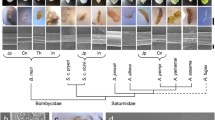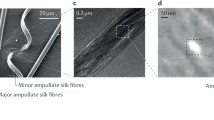Abstract
Honeybee silk is released from secretory cells and polymerises as birefringent tactoids in the lumen while silk is spun by a spinneret at the tip of the labium–hypopharynx and contains ά-helical proteins arranged in a four-strand coiled-coil structure. Wet fibres are only half as stiff as dried ones, but are equal in strength. The fibroin is hygroscopic and lithium thiocyanate and urea eliminate the yield point tested on both dry and wet fibres. The slopes of the solvent-related curves are reduced compared to those tested in water. Silk sheets are independent of temperature when deformed in tension. This fibre is rather crystalline and its hydration sensitivity, expressed as the ratio of the elastic modulus of wet to that of dry fibre, is 0.53. The ά-helical fibroins are predicted to have an antiparallel tetrameric configuration that is shown as a possible structural model. The molecular structure of ά-helical proteins maximizes their robustness with minimal use of building materials. In conclusion, it appears that the composition, molecular topology and amino acid content and sequence are a highly conserved feature in the evolution of silk in Apis species.






Similar content being viewed by others
References
Ackbarow, T., Chen, X., Keten, S., Buehler, M.J. (2007) Hierarchies, multiple energy barriers and robustness govern the fracture mechanics of ά-helical and β-sheet protein domains. Proc. Nat. Acad. Sci. 104, 16410–16415
Ackbarow, T., Sen, D., Thaulow, C., Buehler, M.J. (2009) alpha-Helical protein networks are self protective and flaw-tolerant. PLoS One 4(6), e6015. doi:10.1371/journal.pone.0006015
Andersen, S.O., Weis-Fogh, T. (1964) Resilin. A rubberlike protein in arthropod cuticle. Adv. Insect Physiol. 2, 1–65
Arnhart, L. (1906) Die Zwischenräume zwischen den Wachsdrussenzellender Honigbiene. Zool. Anz. 30, 719–721
Atkins, E.D.T. (1967) A four-strand coiled-coil model for some insect fibrous proteins. J Mol Biol 24, 139–141
Buehler, M.J., Ackbarow, T. (2007) Fracture mechanics of protein materials. Mater Today 10, 48–58
Buehler, M.J., Keten, S. (2008) Elasticity, strength and resilience: A comparative study on mechanical signatures of α-helix, β-sheet and tropocollagen domains. Nano Res 1, 63–71
Chauvin, R. (1962) Sur le noircissement des vieilles cires. Ann. Abeille 5, 59–63
Flower, N.E., Kenchington, W. (1967) Studies on insect fibrous proteins: the larval silk of Apis, Bombus and Vespa (Hymenoptera: Aculeata). J. R. Micro. Soc. 86, 297–310
Hepburn, H.R. (1986) Honeybees and wax. Springer, Berlin
Hepburn, H.R., Kurstjens, S.P. (1984) On the strength of propolis (bee glue). Naturwissenschaften 71, 591–592
Hepburn, H.R., Kurstjens, S.P. (1988) The combs of honeybees as composite materials. Apidologie 19, 25–36
Hepburn, H.R., Chandler, H.D., Davidoff, M.R. (1979) Extensometric properties of insect fibroins: the green lacewing cross-β, honeybee ά-helical and greater waxmoth parallel-β conformations. Insect Biochem. 9, 69–77
Hepburn, H.R., Armstrong, E., Kurstjens, S.P. (1983) The ductility of native beeswax is optimally related to honeybee colony temperature. S. Afr. J. Sci. 79, 416–417
Hepburn, H.R., Muerrle, T., Radloff, S.E. (2007) The cell bases of honeybee combs. Apidologie 38, 268–271. U KRSTJENS S.P., 1983
Huber F. (1814) Nouvelles Observations sur les Abeilles. [English translation 1926] Dadant, Hamilton
Jay, S.C. (1964) The cocoon of the honeybee, Apis mellifera L. Canad. Ent. 96, 784–792
Kurstjens, S.P., Hepburn, H.R., Schoening, F.R.L., Davidson, B.C. (1985) The conversion of wax scales into comb wax by African honeybees. J. Comp. Physiol. B156, 95–102
Kurstjens, S.P., McClain, E., Hepburn, H.R. (1990) The proteins of beeswax. Naturwissenschaften 77, 34–35
Lucas, F., Rudall, K.M. (1968) Extracellular fibrous proteins: the silks. In: Florkin, M., Stotz, E.H. (eds.) Comprehensive biochemistry, vol. 26, pp. 475–558. Elsevier, Amsterdam
Lucas, F., Shaw, J.T.B., Smith, S.G. (1960) Comparative studies of fibroins: I. The amino acid composition of various fibroins and its significance in relation to their crystal structure and taxonomy. J Mol Biol 2, 339–349
Pirk, C.W.W., Hepburn, H.R., Radloff, S.E., Tautz, J. (2004) Honeybee combs: construction through a liquid equilibrium process? Naturwissenschaften 91, 350–353
Rudall, K.M. (1962) Silk and other cocoon proteins. In: Florkin, M., Mason, H.S. (eds.) Comparative biochemistry, vol. IV, pp. 397–433. Academic, New York
Rudall, K.M. (1965) Aspects of Insect Biochemistry. Academic, London
Shao, Z.Z., Vollrath, F. (2002) Materials: surprising strength of silkworm silk. Nature 418, 741
Shi, J., Lua, S., Du, N., Liu, X., Song, J. (2008) Identification, recombinant production and structural characterization of four silk proteins from the Asiatic honeybee Apis cerana. Biomaterials 29, 2820–2828
Silva-Zacarin, E.C.M., De Moraes, R.L.M.S., Taboga, S.R. (2003) Silk formation mechanisms in the larval salivary glands of Apis mellifera (Hymenoptera: Apidae). J. Biosci. Bangalore. 28, 753–764
Sutherland, T.D., Campbell, P.M., Weisman, S., Trueman, H.E., Sriskantha, A., Wanjura, W.J., Haritos, V.S. (2006) A highly divergent gene cluster in honeybees encodes a novel silk family. Genome Res 16, 1414–1421. Coil
Sutherland, T.D., Weisman, S., Trueman, H.E., Sriskantha, A., Trueman, J.W.H., Haritos, V.S. (2007) Conservation of essential design features in coiled-coil silks. Mol Biol Evol 24, 2424–2432
Sutherland, T.D., Young, J., Weisman, S., Hayashi, C.Y., Merrit, D. (2010a) Insect silk: one name, many materials. Annu. Rev. Entomol. 55, 171–188
Sutherland, T.D., Haritos, V.S., Trueman, H.E., Sriskantha, A., Weisman, S., Campbell, P.M. (2010) United States Patent Application Publication. US2010/0100975 A1. April 22 2010
Sutherland, T.D., Church, J.S., Hu, X., Huson, M.G., Kaplan, D.L., Weisman, S. (2011a) Single honeybee silk protein mimics properties of multi-protein silk. PLoS One 6(2), 16489. doi:10.1371/journal.pone.0016489
Sutherland, T.D., Weisman, S., Walker, A.A., Mudie, S.T. (2011b) The coiled-coil silk of bees, ants, and hornets. Biopolymers 97, 446–454
Sutherland, TD, Weisman, S, Walker, AA, and Mudie, ST (2012). Invited review: The coiled coil silk of bees, ants, and hornets. Biopolymers 97, 446–454
Verlich, A.V. (1930) Entwicklungsmechanische Studien an Bienenlarven. Z. Wiss. Zool. 136, 210–222
Vollrath, F., Knight, D.P. (2001) Liquid crystalline spinning of spider silk. Nature 410, 541–548
Wainwright, S.A., Biggs, W.D., Currey, J.D., Gosline, J.M. (1976) Mechanical design in organisms. Edward Arnold, London
Warwicker, J.O. (1960) Comparative studies of fibroins: II. The crystal structures of various fibroins. J Mol Biol 2, 350–362
Woolfson, D.N. (2005) The design of coiled-coil structures and assemblies. Adv. Protein Chem. 70, 79–112
Zhang, K., Si, F.W., Duan, H.L., Karihaloo, B.L., Wang, J. (2010a) Hierarchical, multilayered cell walls reinforced by recycled silk cocoons enhance the structural integrity of honeybee combs. Proc. Nat. Acad. Sci. 107, 9502–9506
Zhang, K., Si, F.W., Duan, H.L., Wang, J. (2010b) Microstructures and mechanical properties of silks of silkworm and honeybee. Acta Biomater 6, 2165–2171
Acknowledgments
We thank Tara Sutherland for kind permission to use some of her previously published figures and to TS, Colleen Hepburn and Catherine Sole for their comments on an earlier version of this manuscript. We acknowledge permission from John Wiley and Sons to use published figures from Sutherland et al. (2011b).
Author information
Authors and Affiliations
Corresponding author
Additional information
Manuscript editor: Peter Rosenkranz
Propriétés physiques de la soie produite par les abeilles: synthèse des connaissances
Abeille / Apidae / soie / fibroïne / hélice alpha
Physikalische Eigenschaften der Seide von Honigbienen: Ein Review.
Apis / Honigbiene / alpha-Helix / Fibroin
Rights and permissions
About this article
Cite this article
Hepburn, H.R., Duangphakdee, O. & Pirk, C.W.W. Physical properties of honeybee silk: a review. Apidologie 44, 600–610 (2013). https://doi.org/10.1007/s13592-013-0209-6
Received:
Revised:
Accepted:
Published:
Issue Date:
DOI: https://doi.org/10.1007/s13592-013-0209-6




